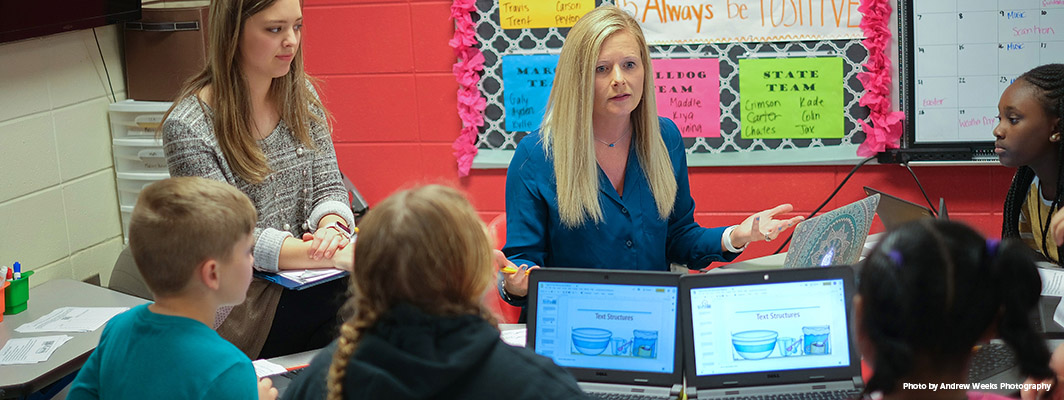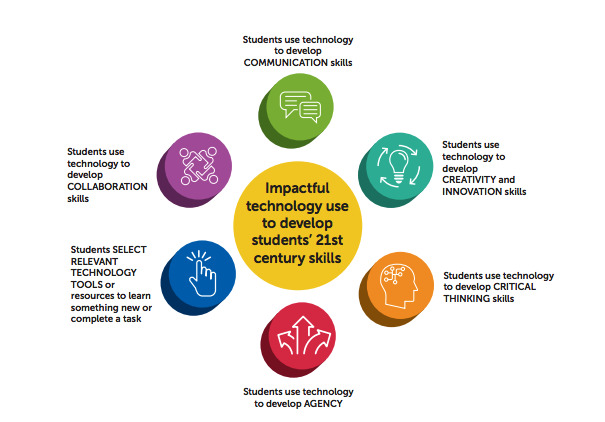
November 19, 2019 | By Mahsa Bakhshaei
As access to technology becomes increasingly commonplace in schools, discrepancies continue to emerge concerning not whether technology is being used, but how it is being used. The U.S. Department of Education’s National Education Technology Plan (2017) calls for “thoughtful intervention and attention” to close this digital use divide, namely by enabling educators to “design highly engaging and relevant learning experiences through technology.” Studies suggest that instructional coaching is one such thoughtful intervention, providing a critical form of professional development to improve teacher practice (Kraft, Blazar, & Hogan, 2018; Knight, 2007).
The Dynamic Learning Project (DLP) is an instructional coaching program launched in 2017 with the goal to help educators use technology in impactful ways that develop students’ 21st century learning skills. Since its launch, the DLP has reached 160 schools in 32 districts across 10 states to support school- and district-based instructional technology coaches with mentoring, professional development, and continuous improvement data.
To help teachers participating in the DLP reflect on their progress in impactful use of technology, DLP researchers and practitioners developed an Impactful Technology Use (ITU) Rubric and associated survey questions. Previous studies provided resources and tools that inform teacher practices around students’ 21st century learning competencies (National Education Association, 2012; Hixson, Ravitz, & Whisman, 2012). However, there was still a need for high-quality tools that help educators purposefully use technology to develop students’ 21st century skills through learning experiences. The existing tools for supporting meaningful technology use were neither fully aligned with 21st century skills nor did they provide educators with a framework that guides reflection on growth in technology integration over time (Budhai & Taddei, 2015).
DLP’s Impactful Technology Use Rubric was developed in collaboration with educational researchers and practitioners, and informed by focus groups and surveys where teachers and coaches tested it. The rubric includes a total of six indicators of impactful technology use. Five concern the core areas of 21st century skills that have shown very strong statistical reliability in previous 21st century skills’ rubrics—critical thinking, collaboration, communication, creativity, and agency—and a sixth indicator focuses on the selection of relevant technology tools. The definition of each indicator is drawn from a general body of literature on 21st century skills (including National Education Association, 2012), but expanded to include an explicit link to technology use. The Rubric provides illustrative—but not exhaustive—example skills for each indicator.

Indicators of impactful technology use
The ITU Rubric is structured around two dimensions: frequency and proficiency. The frequency dimension asks teachers to rate how often their students engage in ITU activities, while the proficiency dimension asks them to rate their students’ ITU expertise. For each dimension, the Rubric defines five descriptors of development with an illustrative description of student use at the lowest and highest levels of proficiency.
Teachers and coaches can use the ITU Rubric to reflect and plan a path for growth in use of technology to develop students’ 21st century skills. When all indicators are viewed holistically, the Rubric can be used to describe impactful use of technology and illuminate the significance of the use of technology. In addition, each indicator can help educators identify areas of strength and areas where they may want to increase their focus. Instructional coaches can also use the ITU Rubric to understand how they can provide more effective and actionable feedback to teachers around their impactful use of technology. Moreover, when instructional coaches understand the different levels, they can offer personalized mentorship to help teachers improve their practice.
Based on the ITU Rubric, DLP researchers developed survey questions to measure teachers’ short- and long-term progress in impactful use of technology, including impact on student engagement and learning.
These questions are designed to measure short-term teacher and student growth in the frequency and efficiency of their technology use. We recommend using them when surveying teachers at the beginning and at the end of a coaching cycle to measure their growth over time.
These questions are designed to measure long-term teacher and student growth in terms of the frequency of their impactful technology use and its impact on student engagement and learning. We recommend using them at the beginning of the year and at the end of the year—with both teachers who received coaching and who did not—to measure the impact of coaching over time.
For any questions about the content or use of these materials, please contact dlp@digitalpromise.org.
References
Hixson, N. K., Ravitz, J., & Whisman, A. (2012). Extended Professional Development in Project-Based Learning: Impacts on 21st Century Skills Teaching and Student Achievement. West Virginia Department of Education.
Knight, J. (2007). Instructional Coaching: A Partnership Approach to Improving Instruction. SAGE Publications. Retrieved from https://books.google.com/books?id=6xhT3r1KERYC
Kraft, M. A., Blazar, D., & Hogan, D. (2018). The effect of teacher coaching on instruction and achievement: A meta-analysis of the causal evidence. Review of Educational Research, 88(4), 547-588.
National Education Association. (2012). Preparing 21st century students for a global society. National Education Association
US Department of Education. (2017). Reimagining the role of technology in education: 2017 National Education Technology Plan update. Retrieved on September 25, 2019 from: https://tech.ed.gov/netp/teaching/
By Elliott Barnes and Sara Mungall